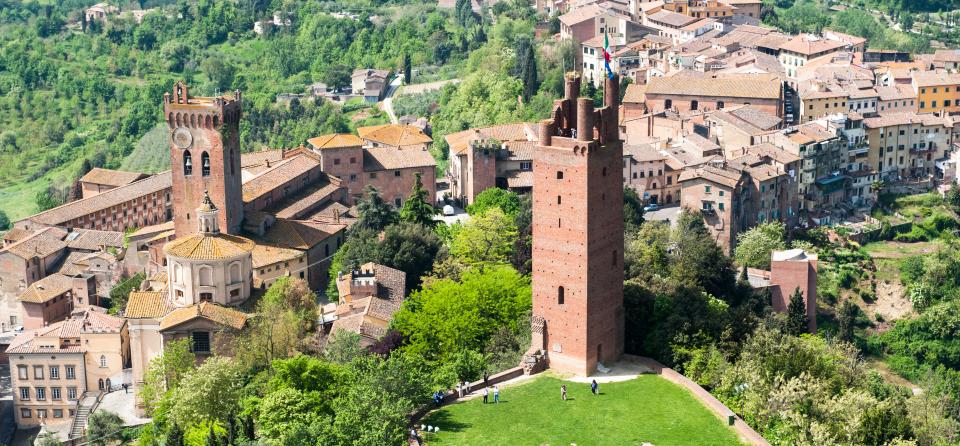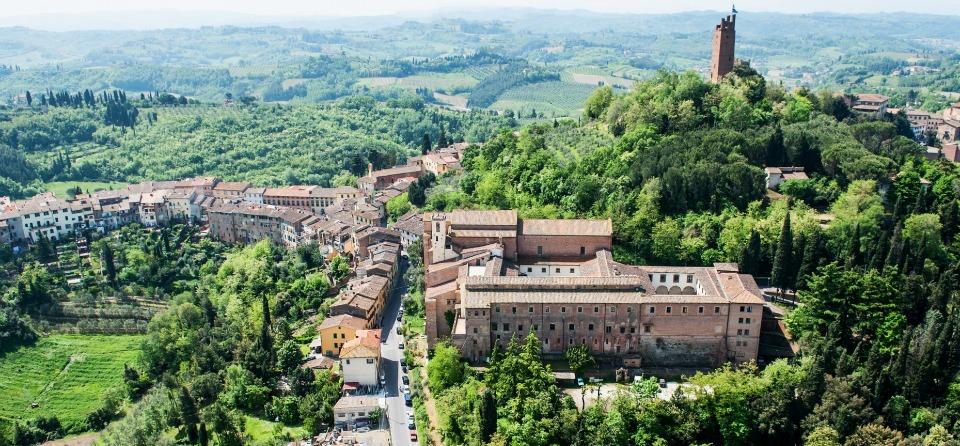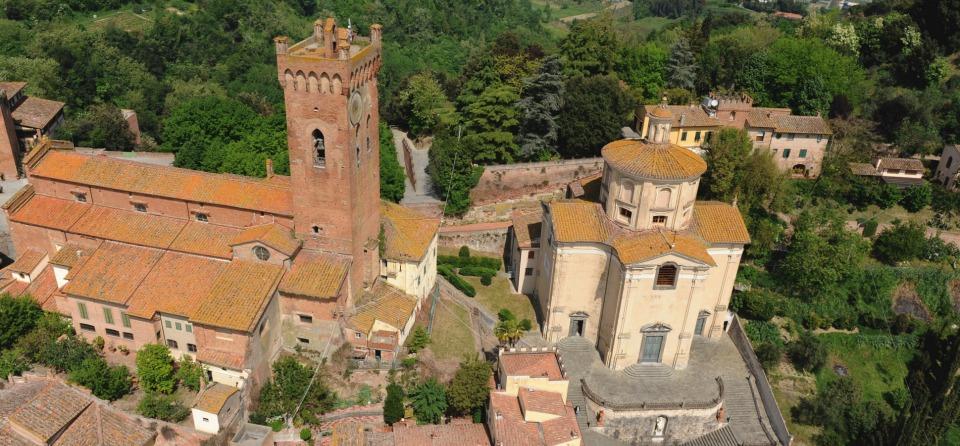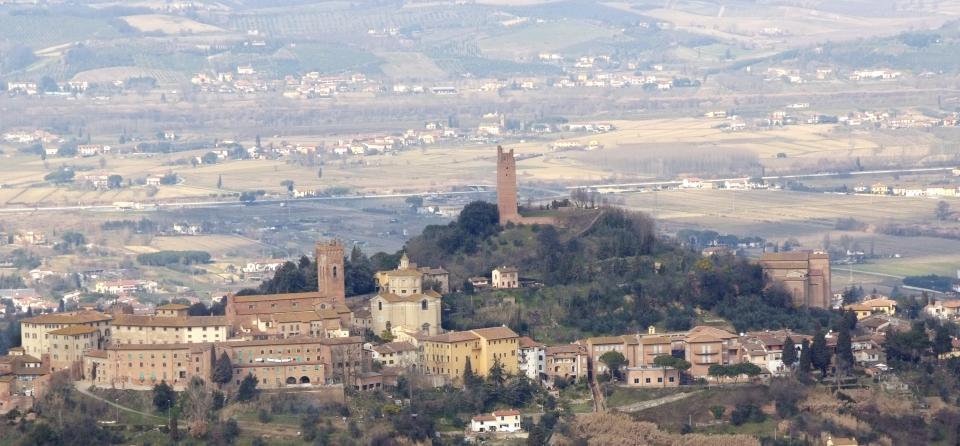- Phone: 33915500740
- Mail: slowfoodsanminiato@alice.it
- Web: www.comune.san miniato.pi.it
- Web: www.sanminiatopromozione.it
San Miniato
Member of the Italian National Network
HISTORICAL NOTES
San Miniato is a land of Etrurian and Roman settlements,as testify the large number of archaeological exavations,which are visible in the archaeological museum of San Miniato.The original nucleous of the town dates back to the VIII century,when Longobards,as testyfied by a document of 713 A.C,built a church dedicated to the martyr Miniato.So the town has German origins and during the Middleages was known as San Miniato al Tedesco.In the space of five centuries San Miniato developed as a medieval rampart and in 962 A.C Othon I of Saxony transformed it into one of the centres of administration.In 1218 Frederick II of Swabia built his castle destining it as the centre of Italy's administration.When Swabian powers declined it,San Miniato becamea free commune(municipality).The town grew with buildings,convents,schools,hospitals and it controlled thirty-five little castles in the area.The communal statutes are testimony to the independence and the fortune of the town.Only at the end of the XIV century did San Miniato have to submit to the rising Florentine Seignory.In 1622 the town was elevated to Diocesan centre.In the XVIII century the town had another big development with the costruction of new public and private buildings,such as churches and nunneries.At the same time it developed its cultural life with the creation of academies and other places of study.At the end of the XIX century San Miniato is a town already defined.It is the Second World War that inflicts a big hit on the town when the German army mined and destroyed a part of San Miniato whose historical Frederick's tower dated back to the XIII century.Parts of buildings and the tower were rebuilt in the 50's.
GEOGRAPHICAL LOCATION
San Miniato is in the centre of north Tuscany.It is equidistant from Pisa,Firenze,Lucca and Siena.The town is situated in a strategic place from where the whole region can be easily reached.It is well served by a good road system and by airports of Pisa and Florence.
SAN MINIATO'S ECONOMY
The economy is not only one of agriculture but also craft.Among the agricultural products we cannot forget the wine(area of Chianti's production)and the olive oil(very good for seasonig).In terms of craft we have to remember the exellent production of leather(it is here,that leather is produced with the trademark Vero Cuoio Real leather).It has been many years since San Miniato also became a touristic destination due to its beautiful landscapes and for its typical food products.
The area of San Miniato is rife with white truffles but also Marzuolo truffles and summer truffles.There are a lot of Agriturismi where you can find hospitality and taste the typical products of the country and the traditional recipes.
PRESIDIO SLOW FOOD(Trademark that guarantees the respect of traditional recipes,the origin of food and therefore the integral use of biological substances)Mallegato.
CONDOTTA SLOW FOODVia Augusto Conti San Miniato(how to find the Association)Contacts T.33915500740 email slowfoodsanminiato@alice.it
TOURISTIC ITINERARIES
-LUDOVICO CARDI'S ITINERARY(He is a painter of the late XVI century)It is an itinerary completely dedicated to the places where Ludovico Cardi(called Il Cigoli) was born and where he found the inspiration for his masterpieces.The itinerary starts in Cigoli where the painter was born and where there was the family's house.The itinerary continues in the Santa Chiara Academy of Music where inside the Museum we can see the beauty of Cigoli's painting:"Noli me tangere"(in addition to a large number of other valuable paintings made by Empoli,Foschi,Orlandi,Bamberini and other painters).At the end we come to the Diocesan's Museum of Sacred Art, in addition to the incomparable paintings here kept(painters like Neridi Bicci,Monaco,Franchi,Cennidi Ser Cenni,L'Empoli,Morandini,Lippi,Posselli,Tiepolo and many others)we can admire"La Madonna in trono con Gesu bambino fra i Santi:Michele Arcangelo e Pietro Apostolo"by Ludovico Cardi called Il Cigoli from the church dedicated to San Michele Arcangelo of Piazzenoli dated and signed 1563.
-BUONAPARTE AND NAPOLEON FAMILY'S ITINERARYNews about the stay of Buonaparte's family in San Miniato can be heard everywhere.Some family members detached themself from this family branch for moving to Corsica,but Napoleon's father,Carl was already called Nableman of San Miniato from Aiaccio when he graduated in Pisa.The proof that the two branches were very close is that Carl inherited all properties of Moccio Buonaparte(the last Buonaparte from San Miniato).in 1780.Our trip begins from Santa Chiara Academy of Music where inside the Museum we can find testimony of the stay of Buonaparte's daughters.Carrying on our trip we are in Via IV Novembre where there was one of the family's palaces.The Buonaparte's palace is today the location of the San Miniato's Bank(Cassa di Risparmio di San Miniato).It was built in the XVI century.The traces of this family are in the cathedral too.The Buonaparte family founded there a canonry in 1488 where there are some gravestones and tombs of Buonaparte's family.In the Hall of Council in the municipality building we can understand how Buonaparte's family participated in the rebellion against the Florentine domination.Buonaparte square is where this family built their own houses after they came to San Miniato in the XIII century.On the southside of the square we can find the Buonaparte's palace today property of San Miniato's Bank.The palace with shapes of Renaissance has maintained the original appearance outside,while inside it has been renovated.The Santissimo Crocifisso's Church was built between the end of the XVII century and the beginning of the XVIII century with a large conribution from the Buonaparte family.The San Sebastiano and San Rocco church was built at the beginnig of the XVI century where the family had a big lodge which they donated for building the new church.Continuing on Via Maioli you can find Filippo Buonaparte's palace.On the right side there is another palace owned by the Buonaparte family.Here the young Napoleon stayed with the father and in 1796 the General came back to visit the uncle Filippo,the last descendant of the San Miniato family branch.On the front of the palace there is a commemorative plaque that remembers this important visit.Continuing you find the Euteleti Academy.Here there is Napoleon's funerary mask.In the San Francesco church on the right side of the wall there are two altars and the Buonaparte family tomb.In the Santa Lucia church there are other tombs of the family.Toward Calenzano you can find "La Selva" a country house owned by the family since the first half of the XVI century.In 1734 Gregorio Buonaparte built a chapel there.In Corrazzano there is another Buonaparte country house,where at the entrance you can find the family's coat of arms which dates back to 1473.
-ON THE TRUFFLE ROADS Followed by expert searchers of truffles we go along the Vald'Egola with special truffle dogs to finding this precious tuber.In these valleys and hills,in addition to the search of truffle you can find the architectonical masterpieces that have been created by San Miniato's families,like country houses,churches,castles and little villages surrounded by the nature.In the neighbourhood of San Miniato is San Quintino where the Roffia family built a country house in the XVI century.Here you can also find the old castle's church.Continuing you can admirethe Ansaldi Villa near Marzana and walking further in the search of truffles toward Corrazzano you can see the Gucci Villa,Buonaparte Villa(now called Pancanti),Collebrunacchi's Villa and San Giovanni church built in the VII century.In Vald'Egola there is still the small village of Montebicchieri,where there is an old castle that was ruled by San Miniato.This castle was later transformed into the Compagni Villa.where you can find the Santa Lucia church built in the XIV century.Nearby in the Palagio area there is San Miniati Pazzi Villa.Bucciano is another small village surrounded by the nature where there is an old castle structure later trasformed into a village.Here you can find San Regolo church of the XIII century and Morali's Villa dating back to the XVII century.Finally there is the Balconivisi church built in 1260.Here you can find the Strozzi Medici Villa of the XVI century and the San Pietro church built at the end of the XIX century.
-SAN MINIATO AND THE FRANCIGENA ROAD(an old pilgrim road from France to Rome).We begin from the ancient village of San Genesio,or raher,the XXII leg remembered by Sigerico during his journey from Rome to Canterbury.Here you can visit archaeological exavations with the remains of the biggest late medieval church of Tuscany and the Museum.You can go on towards San Miniato which after San Genesio's destruction became the central leg of the pilgrims road.Here,besides visiting the rich historical centre of churches,palaces,convents and monuments, you can visit San Domenico's church,where in addition to the 700 frescos you can admire the remains of 300 paintings among those the boat transport of the remains of San Jacopo from Gerusalem to Galicia.Continuing on you should stop at San Sebastiano and San Rocco church dedicated to the two protector of pestilence.Then continuing along Via Maioli and Via Bagnoli you reach Vicolo Borghizzi where the Via Francigena passed by,sending you on into the countryside of the area.
QUALIFICATIONS OF EXCELLENCE OBTAINED
-PLAN FOR ELIMINATING THE DEFACING OF TRAFFIC SIGNS
-SYSTEM TO CONTROL POLLUTION WITH ELECTROSMOG
-PLANS OF IMPROVEMENT TO THE QUALITY OF SCHOOLS REFECTORIES
-PLANS OF INTERVENTION FOR THE RESTORATION OF HISTORICAL CENTRES AND VALUABLE WORKS OF ART TO THEIR ORIGINAL CONDITION
-A PARKING AREA TO FACILITATE ACCESS FOR RESIDENTS INTO THE CENTRE
PROJECTS ORGANISED WITH OTHER TOWNS
TYPICAL PRODUCTS:
Big production of typical salami:lonzino,salame,prosciutto,spalla,finocchiona,spuma di gota,rigatino,soppressata,salsicce.Also from the pork they have fegatelli,lardo salato and mallegato(under the protection of slow food)
For vegetables we have to remember:San Miniato's beans and articokes,the San Miniato tomatoes and courgettes.Moreover we have:olio di Mignola(special olive oil),wine from the hills of Pisa(Chianti DOCG)and white wine from Pisa Sthorpe DOC,Toscan red wine IGT,Toscan white wine IGC,Vinsanto and others.
From the bakery we have to taste:biscotti di San Miniato produced by "Il Cantuccio di Federigo",schiacciata di Pasqua,schiacciata all'uva,pane di ramerino,Toscan bread and large production of biscuits and sweets.
Cheese:Goats cheese and Pecorino(cheese from sheep).
Finally how can we forget the best product of the area:the truffles.There are three types of truffles:white ones,Marzuolo truffles(found in March)and summer truffles.
TRADITIONAL RECIPES
FRIED EGGS WITH WHITE TRUFFLES.It is said that is the best way to taste truffles.
FRIED MALLEGATO.Fried sausage made with pigs blood
PAPPA AL POMODORO.Stale moist bread with tomatoes and olive oil mixed together and served warm.
